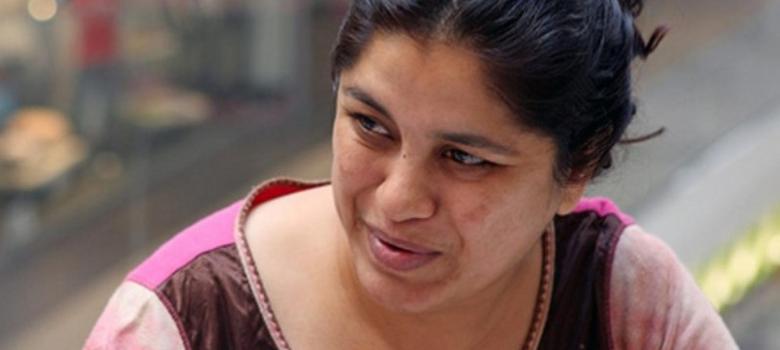
“A garbage collector discovered their bodies in cardboard boxes near the cemetery in the morning,” said PSI Rathore, the investigating officer at the Kandivali West police station. “Right now, we are waiting for the post mortem report to come in before we decide what to do. We are questioning relatives as a matter of procedure.”
Upadhyay’s friends and relatives discovered the two were missing only on Saturday morning, when Bhambhani’s daughter contacted them to ask whether they knew where the two could be. Bhambhani did not return home on Friday night and Upadhyay was last seen online on Friday evening. Repeated messages to the two went unanswered through Saturday.
Bhambhani, a family lawyer, had been representing Upadhyay as she went through the process of divorcing her husband Chintan Upadhyay, also an artist.
“She’s a wonderful artist and friend,” said Archana Hande, her senior at Baroda who remained her friend in Mumbai. Hande was at the Kandivali police station assisting the authorities with their inquiries. “She was cheerful and enthusiastic. I could have accepted [her death] if it was an accident, an illness. This kind of brutality – I have no words for it.”
From Baroda to Bombay
Upadhyay was well known as one of the rising stars of her generation of artists. Born Hema Hirani in Baroda in 1972, Upadhyay studied at the Faculty of Fine Arts at Sayajirao University. There she met and married her husband Chintan.
The two moved to Mumbai in the late 1990s, moving from one flat to another before finally settling in Juhu. City tabloids highly publicised their separation in 2010 and later their divorce proceedings, which are still ongoing.
“I remember a time when Hema and Chintan – two innocent unspoilt art graduates – had moved from Baroda to Bombay,” said Nancy Adajania, a critic and curator close to Upadhyay. “I guess the Balzacian art world took a toll on their relationship.”
Adajania added, “But to concentrate on the personal life of a woman artist is to perform a great disservice to her work. I would like to remember her as an artist who in the early 2000s reflected on urban entropy through a feminist perspective by reconfiguring the genre of self-portraiture.”
A promising artist
Upadhyay had her first solo at Chemould Art Gallery in 2001. This was a montage of photographs of parts of herself inserted into an urban landscape. Her first international solo was The Nymph and the Adult in Sydney, again in 2001. This featured 2,000 tiny handmade sculptures of cockroaches across the gallery.
“She fell in love with Bombay as a city and became interested in the downtrodden – which became as a sign of her work,” said Riyas Komu, an artist and sculptor who knew her. “As an artist she was very interested in people’s lives.”
Her later art continued to explore the city and urban forms. Over time, she shifted to large-scale sculptures of slums or shanty towns. One of these, a globe made of shanty towns, hangs in Maker Max City in Bandra-Kurla, one of the world’s most expensive office spaces.
“One word I would use for her is ‘obsessive’,” said Shireen Gandhy, who heads Chemould Art Gallery. “She had the patience to work with small objects. With her slum work, she did all the cutting and painting and chopping mostly by herself, because this was the time before assistants.”
Upadhyay shifted scale once again in recent years with her latest medium, rice, using it to talk about urban issues and the use of urban space.
“She had a fantastic sense of scale,” Gandhy said. “She was not afraid of attempting ambitious work. When she worked with paper, there was beauty and aesthetic; it was pleasing. When she worked with sculpture, she really did it with aplomb.”
Her art, said Peter Nagy, curator of the Gallery Nature Morte in Delhi which has exhibited her work, was focussed.
“She had a lot of promise, and was just at the beginning of her career,” Nagy said. “She was very easy to work with. She wasn’t confused about her work, and was sure about what she wanted to do. She could have made more, but she didn’t want to overproduce.”
Generous in friendship
All those who knew her unanimously remembered her as a hardworking and caring person who was deeply focussed on her art.
“She was just a warm, generous person,” said Ranjit Hoskote, a poet and art critic. “Despite all turbulences, she always came across as a composed, gentle soul. This is such a shock.”
Gandhy remained close to Upadhyay well after her first solo show.
“It was a very professional dialogue, but it was also a friendship,” Gandhy said. “She was a lovely person, just a sweetheart. Sometimes she was stupid, sometimes silly, sometimes intelligent. You would sometimes think she was naïve, but then she would come up with an idea with such great depth and intelligence.”
Upadhyay was also a private person, she said, who once coaxed into company, was happy.
“Whatever else was going in her life, her art dominated,” said Gandhy. “Sometimes other stuff took over, but when it came to her work, she just focussed on it completely.”
Said Hande, “I still haven’t come to terms that she is not there. We have just done the formalities, but I still think she will come back tomorrow and say something on Whatsapp.”



